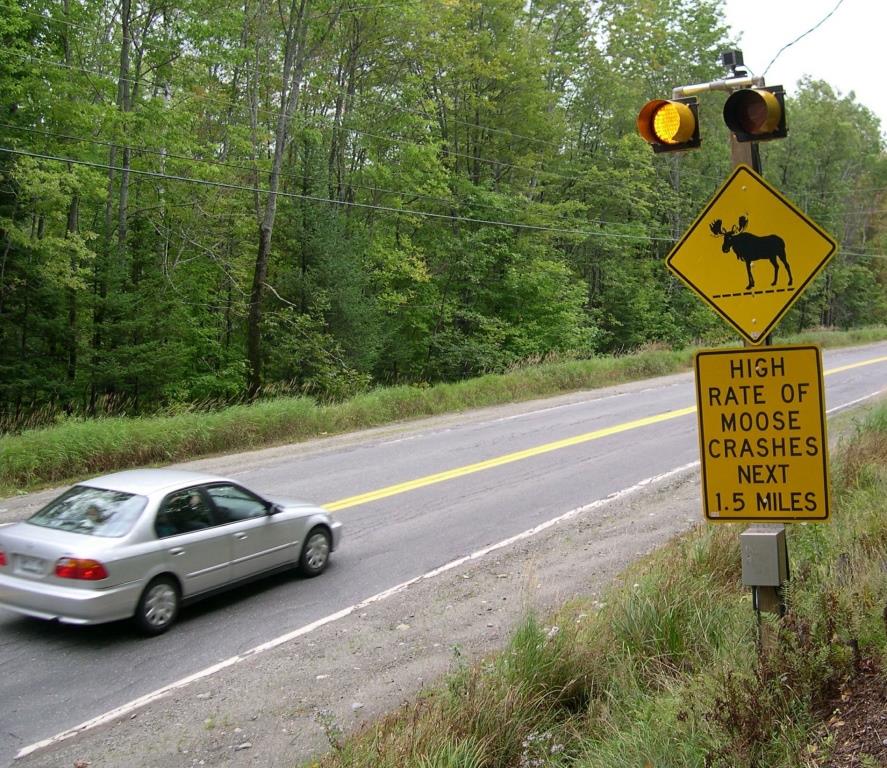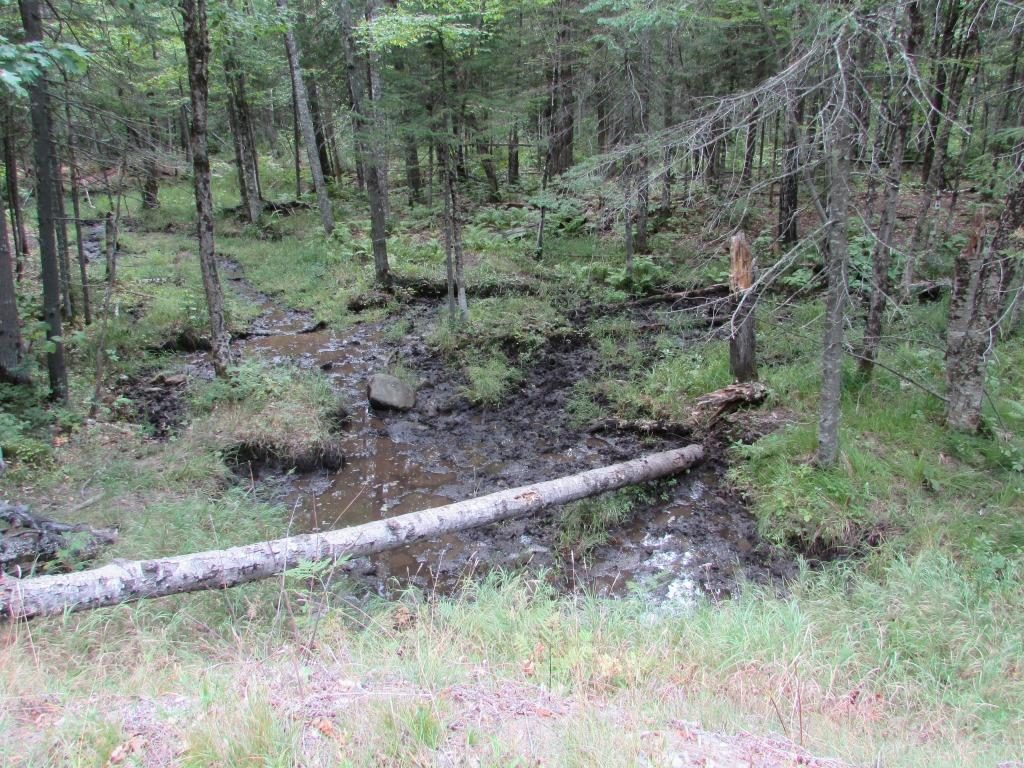September 22, 2016 at 4:21 pm
By Bob Cordes, IFW Wildlife Biologist
[caption id="attachment_1960" align="alignright" width="424"] Motion-activated signs such as this one alert motorists to areas of high moose activity[/caption]
This past week I was fortunate enough to attend and deliver a presentation at the Northeast Transportation and Wildlife conference held in Lake Placid, New York. In addition to the great scenery around the venue, this conference is particularly interesting because it provides collaboration among professionals from a variety of agencies related to wildlife and transportation allowing the transfer of ideas and information – mostly about how to get fish and wildlife across transportation networks safely for the animals and the people.
My presentation was titled: Predicting Moose Crossing Hotspots in Western Maine Using Habitat Connectivity Models. It was co-authored with IFW Wildlife Biologists Chuck Hulsey and Amanda Shearin and MaineDOT’s Devon Witherell. The focus of the presentation demonstrates this collaboration between agencies as I discussed an effort in Western Mountains of Region D to identify, GPS, measure roadside moose wallows along all state numbered highways.
Wallows are identified so we can identify the problem or hazard areas of a road. Depending on moose activity in the wallow, we rated them on a scale of 1-6. We also took note of the sightlines.and the number and length of skidmarks.
We use this information in order to install the appropriate safety measures such as warning signs not only to protect drivers and their passengers, but also Maine’s moose.
[caption id="attachment_1959" align="aligncenter" width="1024"]
Motion-activated signs such as this one alert motorists to areas of high moose activity[/caption]
This past week I was fortunate enough to attend and deliver a presentation at the Northeast Transportation and Wildlife conference held in Lake Placid, New York. In addition to the great scenery around the venue, this conference is particularly interesting because it provides collaboration among professionals from a variety of agencies related to wildlife and transportation allowing the transfer of ideas and information – mostly about how to get fish and wildlife across transportation networks safely for the animals and the people.
My presentation was titled: Predicting Moose Crossing Hotspots in Western Maine Using Habitat Connectivity Models. It was co-authored with IFW Wildlife Biologists Chuck Hulsey and Amanda Shearin and MaineDOT’s Devon Witherell. The focus of the presentation demonstrates this collaboration between agencies as I discussed an effort in Western Mountains of Region D to identify, GPS, measure roadside moose wallows along all state numbered highways.
Wallows are identified so we can identify the problem or hazard areas of a road. Depending on moose activity in the wallow, we rated them on a scale of 1-6. We also took note of the sightlines.and the number and length of skidmarks.
We use this information in order to install the appropriate safety measures such as warning signs not only to protect drivers and their passengers, but also Maine’s moose.
[caption id="attachment_1959" align="aligncenter" width="1024"] Moose wallows such as this one can often be found near roads. How frequently the wallows are used can impact the number of moose-vehicle collisions in the area.[/caption]
Moose wallows such as this one can often be found near roads. How frequently the wallows are used can impact the number of moose-vehicle collisions in the area.[/caption]
 Motion-activated signs such as this one alert motorists to areas of high moose activity[/caption]
This past week I was fortunate enough to attend and deliver a presentation at the Northeast Transportation and Wildlife conference held in Lake Placid, New York. In addition to the great scenery around the venue, this conference is particularly interesting because it provides collaboration among professionals from a variety of agencies related to wildlife and transportation allowing the transfer of ideas and information – mostly about how to get fish and wildlife across transportation networks safely for the animals and the people.
My presentation was titled: Predicting Moose Crossing Hotspots in Western Maine Using Habitat Connectivity Models. It was co-authored with IFW Wildlife Biologists Chuck Hulsey and Amanda Shearin and MaineDOT’s Devon Witherell. The focus of the presentation demonstrates this collaboration between agencies as I discussed an effort in Western Mountains of Region D to identify, GPS, measure roadside moose wallows along all state numbered highways.
Wallows are identified so we can identify the problem or hazard areas of a road. Depending on moose activity in the wallow, we rated them on a scale of 1-6. We also took note of the sightlines.and the number and length of skidmarks.
We use this information in order to install the appropriate safety measures such as warning signs not only to protect drivers and their passengers, but also Maine’s moose.
[caption id="attachment_1959" align="aligncenter" width="1024"]
Motion-activated signs such as this one alert motorists to areas of high moose activity[/caption]
This past week I was fortunate enough to attend and deliver a presentation at the Northeast Transportation and Wildlife conference held in Lake Placid, New York. In addition to the great scenery around the venue, this conference is particularly interesting because it provides collaboration among professionals from a variety of agencies related to wildlife and transportation allowing the transfer of ideas and information – mostly about how to get fish and wildlife across transportation networks safely for the animals and the people.
My presentation was titled: Predicting Moose Crossing Hotspots in Western Maine Using Habitat Connectivity Models. It was co-authored with IFW Wildlife Biologists Chuck Hulsey and Amanda Shearin and MaineDOT’s Devon Witherell. The focus of the presentation demonstrates this collaboration between agencies as I discussed an effort in Western Mountains of Region D to identify, GPS, measure roadside moose wallows along all state numbered highways.
Wallows are identified so we can identify the problem or hazard areas of a road. Depending on moose activity in the wallow, we rated them on a scale of 1-6. We also took note of the sightlines.and the number and length of skidmarks.
We use this information in order to install the appropriate safety measures such as warning signs not only to protect drivers and their passengers, but also Maine’s moose.
[caption id="attachment_1959" align="aligncenter" width="1024"] Moose wallows such as this one can often be found near roads. How frequently the wallows are used can impact the number of moose-vehicle collisions in the area.[/caption]
Moose wallows such as this one can often be found near roads. How frequently the wallows are used can impact the number of moose-vehicle collisions in the area.[/caption]Categories